R
race (reys) A group of individuals within a species, all of which possess one or more distinguishing characteristics.
raceme: Spathoglottis plicata illustrating a typical raceme.
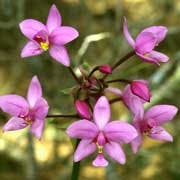
raceme (ray-SEEM) A simple inflorescence of stalked flowers on a common, more or less elongated axis.
racemosus, -a, -um (ras-see-MOH-sus) With flowers borne in racemes, resembling a raceme; racemose.
rachis (RAY-kiss) The axis of an inflorescence.
radians (RAY-di-anz) Radiating outward.
radiant (Ray-dee-nt) Coming from a central point.
radiatus, -a, -um (ray-dee-AY-tus) Spreading out from a common center; with rays; radiate.
radical (RAD-i-kul) Of or arising from the root or base of the stem.
radicans: Epidendrum radicans has rooting stems.

radicans (RAD-ik-anz) Having rooting stems.
radicle (RAD-i-kul) The embryonic plant root.
radix (RAY-diks) A root.
raft (rahft) A large, flat basket made of interlocking pieces of wood.
rameal (RAY-mee-al) Belong to a branch.
ramifaction (rahm-ih-FIH-kay-shun) Branching.
ramicaul (RAM-i-kall) A morphologic term for the so-called "secondary stem" of the Pleurothallidinae.
ramosus, -a, -um (ram-OH-sus) Branched; ramose.
ramulose (RAM-yuh-lohs) Having many branches.
Rangaeris (ran-gah-ER-is) The six species in this genus are widespread throughout tropical Africa. Summerhayes described the genus in 1936, naming it Rangaeris, an anagram of Aerangis, to which it is related.
raniferus, -a, -um (ran-NI-fer-us) With a frog-like callus .
ranks (rangks) Rows, as in the arrangement of flowers in an inflorescence.
raphe (RAYF-a) A ridge.
raphides (RAYF-ids) Needlelike crystals, usually of calcium oxalate, which occur in the cells of many plants.
rarus, -a, -um (RARE-us) Rare; uncommon.
raucus, -a, -um (RAW-kus) Hoarse; raw; raucous.
receptacle (re-SEP-ta-kul) The summit of the flower stalk bearing the floral organs.
recessive (ree-SESS-iv) Said of an allele that is not expressed when paired with a dominant allele; also, the phenotypic character thereof.
reciprocal cross (ree-SIP-ro-cul kraws) A repeat of a cross in which the original roles of the pollen and seed parents are reversed.
reclinatus, -a, -um (rek-lin-AY-tus) Bent backward; reclining; reclinate.
recondite (REK-on-dyet) Concealed; difficult to make out; not easily recognized.
rectum: Cymbidium rectum has an upright inflorescence.
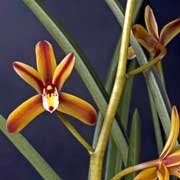
rectus, -a, -um (REK-tus) Upright; erect.
recurvus, -a, -um (ree-KER-vus) Bent backward, recurved.
reflasking (ree-flask-ing) Transplanting small seedlings from one flask into a flask of fresh medium to permit greater growth before deflasking the seedlings into community pots or thumb pots.
reflexus, -a, -um (ree-FLEK-sus) Abruptly bent backward or downward; reflexed.
refulgens (ree-FUL-jenz) Shining brightly.
regalis, -e (ree-GAY-liss) Of outstanding merit; regal.
reginae (re-JYE-nee) Of the queen; queenly.
registrant (rej-ih-STRANT) The person or firm in whose name an application is made for the registration of an orchid hybrid.
registrar (rej-ih-STRAR) The official for the Royal Horticultural Society (London) International Registration Authority of the responsible for the processing of applications to register orchid hybrids.
registration (rej-is-STRAY-shun) The process and procedures for the recording of the name and parentage of a new orchid hybrid under the jurisdiction of the International Registration Authority.
regius, -a,-um (REE-jee-us) Royal; regal.
regular (REG-yuh-ler) Uniform or symmetrical in shape or structure.
regulator gene (reg-yuh-LAY-tore jeen) Any gene that controls the expression of another gene.
Reichenbach: Heinrich Gustav Reichenbach.

Reichenbach, Heinrich Gustav (1824—1889) An eminent German orchidologist born in Dresden. His activity was chiefly that of describing new species, especially new horticultural introductions, and monographing certain genera. His papers were scattered in numerous journals, especially in The Gardener's Chronicle; his most important single work was Xenia Orchidacea (1854—1900), a three-volume illustrated work. He was the son (filius in Latin) of an equally eminent botanist and thus he is also known as the younger Reichenbach or Reichb.f.
remotus, -a, -um (ree-MOH-tus) Scattered; not close together; remote.
Renanthera (ren-ANN-ther-ah) A genus of 17 species of epiphytic and hemiepiphytic orchids distributed from southeast Asia through Malaysia and the Philippines, related to Vanda and Arachnis. Established in 1790 by Loureiro, the name alludes to the kidney-shaped pollinia of the flowers.
Renantherella (ren-ANN-ther-ell-a) At least one epiphytic species is known in this genus native to peninsular Thailand and Malaya south to Borneo. Ridley established the genus in 1896, using the diminutive form of Renanthera, due to their similarity.
reniform: Cuitlauzina pendula has a reniform lip.
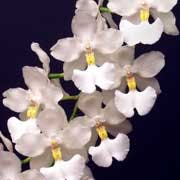
reniform Kidney-shaped
resiniferous Resin producing.
repandens (ree-PAN-denz) With a gently wavy or fluted margin; undulate; repand.
repens (REE-penz) Creeping; prostrate and rooting at the nodes; repent.
replicatus, -a, -um (rep-li-KAY-tus) Doubled back; folded; replicate.
respiration (res-per-AY-shun) The processes used by organisms to produce metabolically usable energy from oxidative breakdown of food.
Restrepia (re-STREP-ee-a) There are about 30 miniature epiphytic species in this genus ranging from Mexico south to northern Argentina. Humboldt, Bonpland and Kunth described the genus in 1815, naming it in honor of Sr. Jos— E. Restrepo, who worked on the geography of the Andes.
Restrepiella (re-STREP-ee-ell-a) A monotypic epiphytic genus from tropical Central America. Garay and Dunsterville described the genus in 1966, using the diminutive form of Restrepia due to their likeness.
resupinate: Most orchids including Cattleya labiata have resupinate flowers.
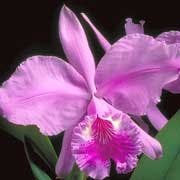
resupinate (re-SOO-pin-ayt) With the lip on the lower side of the flower in respect to the rachis; used to refer to flowers with the lip lowermost regardless of orientation.
reticulatus, -a, -um (re-tik-yew-LAY-tus) In the form of a network; reticulate.
reticulum (re-TIK-yuh-lum) A network of fibers.
retinaculum (ret-in-AK-yuh-lum) In Orchidaceae, the gland where one or more pollinia are attached.
retrorse (re-TRORSS) Directed back or downward.
retusus, -a, -um (re-TEW-sus) Rounded at the end, but with a broad and shallow notch in the center; retuse.
reversion (ree-VER-zhuhn) A change backward to an earlier condition.
reversus, -a, -um (ree-VER-sus) Turned around; reversed.
revolutus, -a,-um (rev-oh-LEW-tus) Rolled backward from the margin or apex; revolute.
rhachis (RAY-kiss) See rachis.
rhizomatose (RYE-zoh-mah-tose) Having the characteristics of a rhizome.
rhizome: A cattleya hybrid showing the rhizome.

rhizome (RYE-zohm) A root-bearing stem, prostrate on or under the ground, the apex of which progressively sends up leafy shoots.
rhizome clip (RYE-zohm klip) A bent piece of heavy wire that fastens to the side of a pot, used to stabilize a newly potted orchid that bears a rhizome.
rhizome clip: Rhizome clips are used to keep a newly potted orchid stable.

rhombic (ROM-bik) Top-shaped; an equilateral figure having oblique angles.
rhomboid (ROM-boyd) Having the shape of a rhombus, i.e., a parallelogram with oblique angles and equal sides.
Rhyncholaelia (rink-oh-LAY-lee-ah) There are two epiphytic species in this genus native to Mexico, Guatemala, Honduras and Belize. Schlechter established the genus in 1918, deriving the generic name from two Greek words meaning "snout" and "laelia." in reference to the very long ovaries characteristic of the the two species, R. digbyana and R. glauca.
RHS (Royal Horticultural Society) Horticultural society based in London; responsible for registering orchid hybrids.
Rhynchocentrum (rink-oh-SEN-trum) A hybrid genus between Ascocentrum and Rhynchostylis created in 1963.
Rhynchostylis (rink-oh-STYE-liss) A genus of three species of epiphytic orchids, widely distributed from India and Ceylon through Burma, Indo-China and Malaysia to the Philippines, related to Aerides and Vanda. It was first described by Blume in 1825, the name alluding to the beaked column of the type species.
rib (rib) In a leaf or similar organ, the primary vein; also any prominent vein or nerve.
ribonucleic acid (RNA) (RYE-bow-new-CLAY-ik as-id) Nucleic acid formed on a DNA template and involved in directing protein synthesis within the cell.
Richard, Achille (1794—1852) French botanist, son of L.C. Richard, significant for his several works on orchids including his important contribution to Mexican orchidology with H.G. Galeotti.
Richard, Louis Claude Marie (1754—1821) French botanist whose work on European orchids developed an exact and critical terminology of the parts of the orchid plant, particularly the flowers.
Ridley, Henry Nicholas (1855—1956) Versatile English botanist who began his career as an assistant in the British Museum (Natural History) and subsequently became director of the Botanic Garden in Singapore; besides monographic treatments of the genus Liparis, Microstylis, Malaxis and Bromheadia, his works on orchids include those of Madagascar, Borneo and Malaya.
rigidus, -a, -um (RIJ-id-us) Stiff; unbending; rigid.
rimosus, -a, -um (ri-MOH-sus) With cracks or chinks; cracked; fissured; rimose.
ringens: Maxillaria ringens has an open throat.

ringens (RIN-jenz) Gaping; said of labiate flowers with an open throat or mouth.
riparian (RYE-pare-ee-en) Said of plants growing near a stream or river.
rivalis, -e (ri-VAY-liss) Growing along streams.
Rodricidium (rahd-ri-SID-ee-um) A hybrid genus between Oncidium and Rodriguezia created in 1957.
Rodriguezia (rahd-ri-GUESS-ee-ah) A genus of 40 species of epiphytic orchids in South America, extending into Central America and the Caribbean. Related to Comparettia and Ionopsis, it was established in 1794 by Ruiz and Pavon, commemorating the 18th-century Spanish botanist and apothecary, Don Manuel Rodriguez.
Rodrigueziella (rahd-ri-GUESS-ee-ell-a) The five epiphytic species in this genus are native to Brazil. Kuntze described the genus in 1891, dedicating it to Dr. Jo—o Barbosa Rodrigues, an avid orchidologist.
Roezl, Benedict (1823—1885) Famous Czech orchid collector who is commemorated in numerous South American orchids such as Miltoniopsis roezlii.
Rogers, Richard Sanders (1862—1942) Early Australian orchidologist.
Rolfe, Robert Allen (1855—1921) One of the greatest of modern English orchidologists. Essentially self-taught, he began as a gardener at the Royal Botanic Gardens, Kew, and became an assistant in the Kew Herbarium, where he served for 40 years. He founded and for 28 years edited The Orchid Review, monographed the orchids for the Flora of Tropical Africa, co-authored the Orchid Stud Book, and contributed numerous articles on orchids in leading periodicals.
roller shades (ROH-ler sheyds) A curtain, made of slats, evenly spaced, or other shade material that can by means of ropes or cords be rolled and unrolled over the outside or inside of a greenhouse roof (and sometimes sides) to regulate the amount of sunlight admitted.
root (root) The underground portion of a plant. It supports the plant and supplies water and nutrients to the upper portion
rootstock (root-stawk) (See rhizome)
rosette (roh-ZET) A radiating or circular cluster of leaves or other organs.
roseus, -a, -um (ROH-zee-us) Rose-colored; delicate pink; rosy.
Rossioglossum: Rossioglossum williamsianum is a colorful member of the genus.
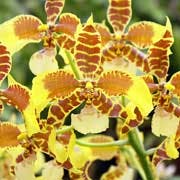
Rossioglossum (ross-ee-oh-GLOSS-um) There are six epiphytic species in this Central American genus ranging from Mexico south to Panama. Schlechter described the genus in 1916, naming it in honor of John Ross, who collected Mexican orchids in the 1830s.
rostellum (ros-TELL-um) A sometimes beaklike extension of the stigma, a gland that produces a viscous substance used in pollination. Also separates the female portion from the male portion of the flower, preventing self-pollination.
rostratus, -a, -um (ros-TRAY-tus) Having a projection like the beak of a bird; beaked; rostrate.
rosula (ross-YUH-la) A rosette.
rosulate (ross-YUH-layt) In the form of a rosette.
rotatus, -a, -um (roh-TAY-tus) Wheel-shaped; rotate.
rotundatus, -a, -um (roh-tund-AY-tus) Nearly circular; rounded; rotund.
rotundifolius, -a, -um (roh-tun-di-FOH-li-us) With round or rounded leaves.
Roxburgh, William (1751—1815) English botanist and illustrator, he described many new species of orchids and other plants of India, where he served as superintendent of the Royal Botanical Garden at Calcutta from 1793 to 1814.
rubellus, -a, -um (roo-BEL-lus) Reddish-colored.
ruber, rubra, rubrum (ROO-ber) Red. In compound words, rubri-.
rubescens (roo-BESS-enz) Rosy red, or suffused with rose; blushing; reddish-colored.
rubro-oculatus, a, -um (roo-broh-ok-yew-LAY-tus) Red-eyed.
rubro-purpureus, -a, -um (roo-broh-purr-PURR-ee-us) Reddish purple.
rubiginosus, -a, -um (roo-bij-in-OH-sus) Rusty; rust-colored; rubiginous.
ruderal (ROO-der-uhl) Growing in waste spaces.
rudimentary (roo-dih-MEN-tah-ree) Arrested in an early stage of development.
Rudolfiella (roo-DOLF-ee-ell-a) The six epiphytic species in this genus are native to tropical South America and Panama. Hoehne identified the genus in 1944, naming it in honor of Dr. Rudolf Schlechter, an avid orchidologist.
rufescens (roo-FESS-enz) Reddish brown.
rugosus, -a, -um (roo-GOH-sus) Roughened by wrinkles; rugose.
rugulosus, -a, -um (roo-gew-LOW-sus) Minutely rugose; finely wrinkled; rugulose.
ruminate (ROO-muh-neyt) Appearing as having been chewed.
runcinate (RUN-suh-neyt) Sharply incised, the segments bent backward.
runner (RUH-ner) A slender trailing shoot taking root at the nodes.
rupestris, -e (roo-PESS-triss) Growing in rocky places; rock-loving.
rupicolous: Formerly included in the group of orchids known as "rupicolous laelias", Cattleya bradei grows on rocks.
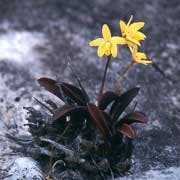
rupicolus, -a, -um (roo-PIK-oh-lus) Growing in cliffs and ledges; rupicolous.
Rupp, Herman Montague Rucker (1872—1956) Australian orchid taxonomist who elucidated the flora of New South Wales.
rust (ruhst) A fungal disease.









